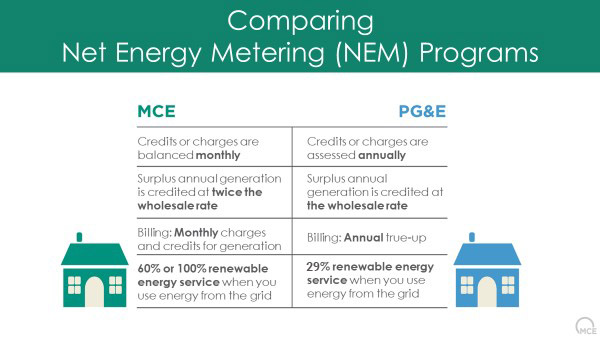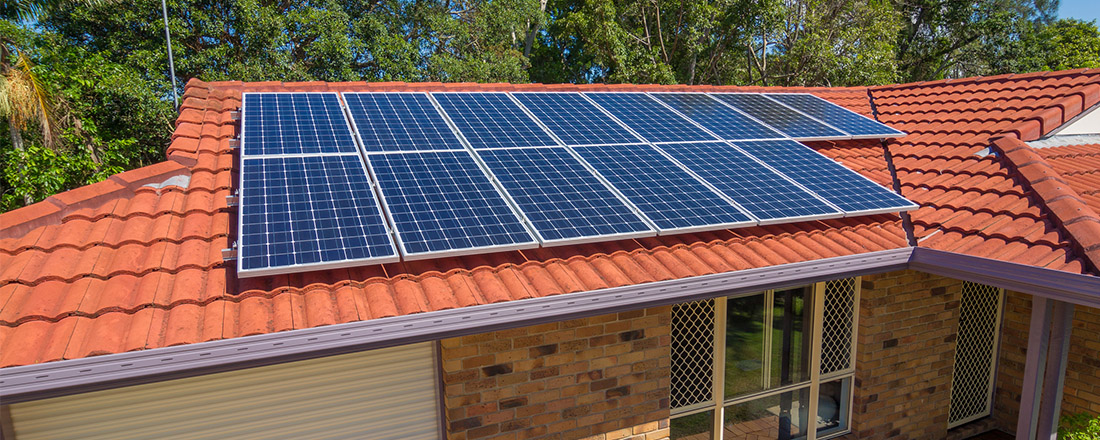Many customers are installing solar on their homes today to reduce their electricity bills and their carbon footprint. Customers with solar are automatically enrolled in Net Energy Metering through MCE and PG&E. Your solar panels will generate energy during the day and send any excess electricity back to the grid. You will receive credits for this excess generation, which are applied to your bill through Net Energy Metering (NEM). Whether you’ve just installed solar, or are new to MCE, it’s important to understand what being a NEM customer means for you.
The MCE Difference
In both MCE’s and PG&E’s programs, when you generate more electricity than you use during the month, you will receive a credit that is automatically applied towards future bills in that 12-month billing cycle. However, with MCE, at the end of that 12-month period, if you’ve produced more electricity than you used overall, you’ll receive a credit at twice the wholesale rate, or double what PG&E’s NEM program offers.
If you have more than $50 in credits at the end of your 12-month cycle, a check (subject to a $5,000 cap) will be sent to the address tied to your electric account. For customers with less than $50 in credits, a credit at retail rate will be applied to future charges on your bill.
In addition, MCE doesn’t request payment in the form of an annual true-up. With PG&E, customers pay a small monthly charge called a minimum delivery charge. At the end of a customer’s 12-month billing cycle, they will be asked to pay their electric bill in full, which is called a true-up. With MCE, customers are credited or charged monthly (instead of annually), so you won’t end up with a year’s worth of charges all at once. PG&E will still continue to true-up customers on the delivery side of the bill, even if you’re an MCE customer.

Top 3 Things to Know About Your Solar with MCE
1. If you have solar on your home, you will still be impacted by the PG&E Public Safety Power Shutoff events.
In the event of an outage, solar installations are designed to disconnect to avoid placing electricity on deenergized lines. As a result, solar alone does not provide backup power during PG&E Public Safety Power Shutoff events. However, battery installations can provide electricity during outage events. A typical battery may provide several hours of energy depending on the size of the system and the amount of electricity being used. Ideally, solar and battery systems can work together to provide a reliable means of replenishing battery storage during an outage event.
2. You will continue to receive one bill from PG&E each month, as well as an annual true-up.
MCE customers will see all of their electric charges on one bill from PG&E. The only difference is generation charges or credits will appear on your monthly bill, while your delivery charges will appear on a yearly basis in the form of a true-up. MCE customers will still have a minimum monthly bill charge from PG&E.
3. MCE’s NEM program works the same whether you own or lease your solar panels.
The individual listed on the interconnection agreement, whether they own or lease, will receive the NEM credits or charges. MCE credits all surplus electric generation from our customers’ panels at retail rates. Credits roll over month-to-month and at the end of the year, customers who generated more electricity than they consumed are credited at MCE’s compensation rate. Cash outs will be automatically issued for customers with $50 or more in credits with a cap of $5,000.
- For more information about MCE’s NEM program and additional frequently asked questions, visit our Solar Customers page.






